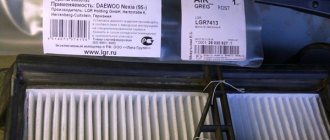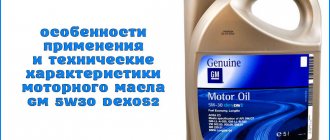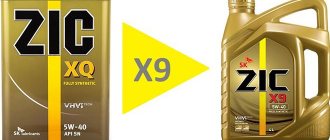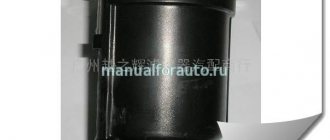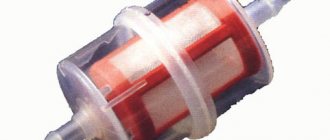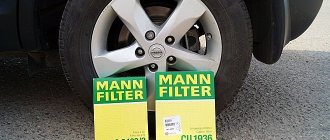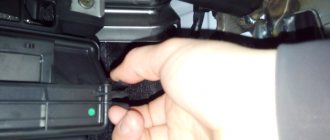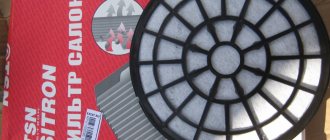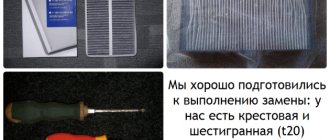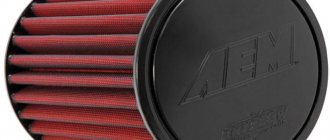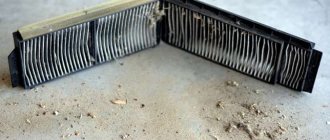Rating of cabin filters among cars
In your opinion, Mahle cabin filters have the best quality. And first place in the ranking of the best. You have left 16 reviews about these filters and only one of them is negative. Such a small number of reviews has led to the fact that Mahle filters occupy only fourth place in the popularity rating. By the way, these same filters are available under the Knecht brand, which also belongs to the Mahle concern. There is no difference between the brands - only in the color of the boxes.
What does the CareMetix biofunctional cabin filter from Mahle look like?
- LA - standard;
- LAK - coal;
- LAO - anti-allergenic.
They also differ in appearance:
- LA have a white filter element;
- LAK - gray;
- LAO - blue.
Mahle anti-allergen filters use CareMetix technology consisting of five layers, which are described in the picture.
The only brand in our selection that does not belong to a large international concern is VIC. Although if you live in the Asian part of Russia beyond the Urals, and even more so if you have a Japanese car, you are well aware of these filters. This is confirmed by your 20 reviews - in those of them where the car is indicated, there is not a single European or domestic car, only “Japanese”.
Read more: Brief review of rifar alum 500
Car owners can understand - the VIC brand belongs to the Japanese Eiken Industries Co. Ltd, who have been producing filters since 1969. What is important is that all factories are still located in Japan. According to the official website, every fourth filter that is installed on out-of-warranty cars in Japan is VIC.
The trick of VIC carbon filters is the presence of electrically magnetized particles that attract contaminants. They do not allow particles larger than 3 microns to pass through and retain most particles between 1 and 3 microns in size (these are the sizes of pollen, fine dust, etc.).
According to information from the official Corteco website, every second new car in Europe has MicronAir filters inside. True, these are engine air filters, but there is no such information on cabin filters. However, it should be noted that the German concern Freudenberg produces a very limited range of spare parts under the Corteco brand.
For example, they do not make oil and fuel filters, but only deal with air filtration - for engines and for people. That is, they are focused on what they really understand. Therefore, it is all the more surprising that Corteco’s assortment does not include anti-allergenic filters - only regular and carbon ones.
Among your 20 reviews about the Corteco filter, there is only 1 negative and 15 positive ones - from owners of different cars, both European, Japanese and Korean.
One of the largest global filter manufacturers in the world. The German company MANN Hummel not only owns its own brand, but also recently bought out Wix Filters, Filtron and Purolator.
Interesting fact - do you know how they appeared? In 1941, Mahle was looking for a buyer for its filter production because they had no time to do it. All resources had to be devoted to the production of pistons for Luftwaffe aircraft engines. Adolf Mann and Erich Hummel bought a ready-made business and began supplying parts to the Wehrmacht themselves. Later, Mahle returned to the production of filters, but it was impossible to get rid of a very powerful competitor.
With MANN in our ratings the situation is classic - the presence of bad reviews does not allow them to gain a foothold in the top of the best ratings. 53 reviews is the third result overall and the best among our top five. But among them there are 6 negative ones and it cannot be said that these are emotional reviews of the “I expected more for the money” type.
Standard MANN filters do not have additional names; carbon filters are called adsotop, and anti-allergen filters are called FreciousPlus. Anti-allergen filters use polyphenol to trap allergens and an antimicrobial coating to prevent the growth of bacteria and mold.
Considering the high positions of other well-known brands and the popularity of Japanese cars in our countries, Denso's results are even a little disappointing. But 21 reviews, of which 4 were negative, did their job. Although, if you look at the negative reviews, the text of three of them suggests that car owners are faced with a fake. After all, the Denso brand is popular and in demand among us.
Despite a fairly wide comprehensive range of various parts, Denso produces only cabin filters and diesel fuel filters - the Japanese do not venture into other segments. Therefore, you should not be surprised that Denso does not offer anti-allergenic filters, only standard and combined (also known as carbon).
Fuel filter overview
The following is a list of popular brands under which fuel filters for gasoline and diesel engines are produced. The rating does not advertise any of the brands represented in it, but was created only on the basis of reviews from car enthusiasts. The following are fuel filters that are better for diesel and gasoline engines.
Mann-Filter fuel filters are manufactured by the German company FilterwerkMann Hummel GmbH, which is one of the largest manufacturers of filter elements in the European Union. Filters are supplied as original parts for cars manufactured under the brands Mercedes-Benz, BMW, Volkswagen, Audi, Opel, Ford, Volvo, Saab, Nissan, Citroen, RENAULT, Peugeot, Fiat, Seat, Komatsu, Caterpillar, Iveco, Rolls- royce, Porsche, Jaguar, Lombargini and others.
Numerous reviews and tests conducted by proactive car enthusiasts show that Mann brand filters are indeed one of the best solutions for modern engines. They provide long-term operation even when using low-quality domestic fuel. The paper is very thick, and the workmanship is excellent.
The only disadvantage we can note is the high price of the filters, comparable to the original. However, it is compensated by a long service life, as well as reliable protection of fuel system elements. The cheapest filters as of the beginning of 2019 cost about 300 rubles.
The BOSCH brand also produces high-quality fuel filters for diesel and gasoline engines. It should be noted that products manufactured by the above-mentioned Mann-Filter company are often sold in BOSCH packaging. However, the quality of these filters is slightly inferior to those made by MANN.
Tests, including dismantling sealed cartridges and Bosch fuel filters, showed that inside there is a high-quality filter element based on thick paper in sufficient quantity and as stated in the documentation.
Filtron
Filtron fuel filters are manufactured by the company of the same name, whose production facilities are located in Poland. Filtron is one of the largest European manufacturers of a wide variety of filters. In particular, its products are used by such automakers as Ford, Volkswagen, Seat, GM, Fiat, LandRover and others.
Filtron fuel filters are very high-quality filter elements that can be installed on almost any car (in accordance with dimensions and other parameters). The advantage of the brand is the wide range of filters produced. The disadvantages include the presence of counterfeits on the market and the rather high cost. Therefore, it is better to buy a Filtron fuel filter in a trusted store. The average price for a filter starts from 300 rubles and above.
Mahle fuel filters, judging by the numerous positive reviews found on the Internet, are among the highest quality and most popular in their market segment. Such filters are installed not only on passenger cars, but also on commercial vehicles. For example, filters of this brand are installed on Volkswagen cars as original ones.
Read more: TOP 5 best oil filters
One of the technological advantages of these filters is the use of corrugated paper in their manufacture. This technology prevents the plates from folding together and also ensures a high-quality filtration process. The original housing is always made with high quality, and the amount of filter paper is quite large.
Delphi
Delphi has its representative offices and production facilities in 33 countries. Accordingly, fuel filters can be produced in different countries. It is noted that it is better to install Delphi filters on a fuel system of a similar brand. This will ensure maximum cleaning and normal operation of the system and the entire engine as a whole. The Delphi line of fuel filters includes samples for installation on cars, SUVs and trucks. The range is very wide.
Reviews of Delphi products are mostly positive. As for negative reviews, they are often written by car owners who either installed them in an unsuitable fuel system or neglected other manufacturer recommendations. Therefore, this brand can be recommended both as original products and after-sales service.
Among the disadvantages of the Delphi brand, it is worth noting only a large number of fakes. However, currently the company reliably protects packaging using high-quality printing, as well as applying a QR code to its surface. This allows you to check the authenticity of the product directly via the Internet.
The UFI company produces various filter elements, including fuel filters under its own brand. Most of the company's production facilities are located in Italy, but there are branches in other European countries, as well as in the USA. UFI filters are distinguished by very high quality manufacturing and reliability.
The quality of UFI fuel filters is confirmed by numerous positive reviews from car owners who have already had the opportunity to use these products. They do an excellent job of filtering. And the range of filters from the UFI company is extremely wide, and you can choose a device for most modern cars.
The brand has two traditional disadvantages - a high price and a large number of fakes. The company successfully combats counterfeits by regularly introducing new levels of protection for original products. You can read more about this on the company’s official website. As for the price, the cheapest filters cost about 300 rubles or more.
Sakura
The Sakura trademark is owned by the Indonesian company ADR Group. Under the mentioned brand, about 100 million different filters are produced annually, mainly for Japanese and South Korean cars. The advantages of Sakura fuel filters are quite good quality and relatively low price compared to European analogues.
Among the shortcomings, it makes sense to note only a large number of fakes on the market. So, when purchasing, you need to pay attention to the presence of two-color printing on the box, the quality of the printing itself, the presence of a product code, as well as a barcode with a company prefix. On the original packaging, in its language, there are always words of gratitude for the purchase.
Main tasks and operating principle
Above we outlined the purpose of the cabin filter. Let us only note that the purified air will also not pollute the car interior with mechanical impurities.
Regarding the operating principle, it is similar to that of all filter elements. The air that passes through the filter element will be cleaned here. At the same time, unlike fuel filters, even ultra-fine particles (0.1 microns) such as pollen are filtered out. There are 2 filtering methods:
- Mechanical. There is special paper inside the filter housing;
- Adsorption. The air in them passes through the carbon element, impurities remain in the pores of the coal.
Adsorption filters are much better as they remove unpleasant odors. In addition, filters are executed in two ways:
- Cartridge. There is no rigid edging; such a filter itself is inexpensive;
- Corpus. It is purchased immediately in a plastic case.
Cabin filters have different shapes, which are dictated by the car model and, accordingly, how much space there is in the engine compartment.
Read more: Brief review of litokol litoflex k80
Regarding the filter element itself, on the market you can find products with two versions: single-layer and multi-layer. The first, also known as a single-layer element, is high-quality paper suitable for retaining dust and dirt. The multilayer element retains impurities from the air passing through it in stages:
Let's summarize: driving with expensive multi-layer filters will be comfortable for those inside the car.
Types of fuel pre-filters
Initially, it should be noted that the purification system conventionally has two stages of filtration. The fuel coarse filter is an element of the first stage of cleaning - in this case, all large particles of debris and dirt are removed from gasoline. As for the second stage, it is designed for fine filtration and this TF is mounted between the engine and the gas tank. Fine cleaning allows you to remove smaller debris from gasoline.
Coarse fuel filter with sedimentation tank
It should also be noted that fuel filter elements are selected individually for each system. This is because each TF for a separate fuel system has its own design and design features. Today you can find TF on sale for carburetor, injection and diesel engines. We are not interested in diesel engines today; the information below is dedicated specifically to gasoline TFs.
In addition, filter elements can also be divided into two types:
- trunk TFs installed specifically in the trunk;
- submersible fuel pumps located in the gas tank itself, along with the pump.
In essence, a coarse TF is a thin mesh that also serves as a reflector. In this case, the mesh allows you to remove all large particles of dirt, as well as chemically harmful impurities from gasoline. The TF structure itself is located in a sump, which is called a glass, and is attached to it using clamps or screws.
To eliminate any gap between the sump tank and the housing itself, the TF is secured using a special paronite gasket. A damper is located at the bottom of the settling tank, which allows the filter element to clean gasoline before it enters the fuel line. In addition, the TF is also equipped with a special valve necessary for reducing injection, which also allows you to regulate the operating pressure in the rail. All these components are installed as additional devices to the direct gasoline injection system. After being removed, excess gasoline is returned to the gas tank without any problems.
Where is?
Coarse filtration mesh
Often the car owner is faced with the need to replace the filter element with his own hands. But not everyone has an idea of where the TF is located, because everything depends on the specific vehicle. Therefore, you need to have this important information, because the problem of clogged fuel pumps can overtake a motorist right on the road.
As a rule, the TF can be located:
- under the bottom of the vehicle;
- in the engine compartment;
- or directly in the gas tank.
What are carbon filters
Only carbon filters can trap the smallest particles of polluted air. Today, coal is the most effective natural absorbent, which is why it has even begun to be used in automobile consumables.
The only thing that charcoal doesn't do well is filter out carbon monoxide. In megacities, the coal resource is consumed very quickly due to the rapid loss of the active layer. The situation is the opposite with nitrogen oxide, the content of which is very high in the air. The carbon element will reduce the concentration of nitrogen compounds by more than ten times. Doctors confirm this: the condition of the mucous membranes of the mouth, eyes and nose improves in drivers.
The pores of coal quickly become contaminated with chemical impurities. After complete saturation, multilayer carbon filters begin to release accumulated impurities into the atmosphere, as a result of which, after their resource is used up, a quick replacement is required - low-quality air will begin to enter the cabin, and the driver and passengers will breathe it.
Rating of car filter brands in Russia
First of all, congratulations to MANN+Hummel, which took a convincing first place. We were also pleased with the good results of the top 5 Russian brands - especially considering the fact that in 4 out of 5 cases they produce products in their homeland. In the overall standings, these five took respectively 5th (BIG Filter), 6th (Livny), 8th (Nevsky Filter), 12th (TSN Citron) and 15th (Goodwill) places. Now about other impressions. Summing up, we studied the distribution of points between brands and found that there is a clear leading group: 10 foreign brands and 5-6 Russian ones. All other brands are losing sharply to this group. By and large, the distribution of points shows that there is room in the market for 15-16 brands aimed at a wide audience. Each of them can occupy its own price-quality niche or attract buyers with other advantages that competitors do not have. The figure can be easily explained by the laws of consumer psychology: even a professional buyer is not able to assimilate more than a dozen brands and maintain close contact with them.
Should other brands die? Not necessary. We were talking about a wide audience, but there are still narrow niches that require special products and a different distribution system: motorsport, military-industrial complex and others. There's enough room for everyone. Provided that manufacturers leave the price war, start searching for their unique buyer and find a unique way to satisfy him.
ai-media.ru
Function of a dirty filter
It was mentioned above that the filter has a replacement schedule. However, the time intervals are highly correlated: driving over rough terrain in the southern regions, where there is always dust on the road, is not the same as driving somewhat further north in winter. Filters suffer most from exhaust gases, insects, and road dust.
Operating the filter at high humidity can be dangerous for the car owner. Wet filters create an environment for parasites and fungi. Over time, they will begin to enter the cabin along with accumulated dust if you do not replace the consumables in time.
Clogging indicators
If necessary, the TF design together with the settling tank can be easily replaced. In general, the replacement process is not particularly complicated, but it is important to know a few nuances in this matter. If you doubt that you can do everything correctly, it is better to ask for help from specialists. As a rule, a fuel filter with a sump becomes clogged after 15 thousand kilometers, although most official manufacturers claim that the filter needs to be changed no more often than every 25 thousand kilometers. However, in this case, everything depends on the mode of use of the car, as well as the quality of the gasoline being filled - the lower the quality, the faster the filter with sump will clog.
Coarse fuel filter with sedimentation tank
It is necessary to highlight several main symptoms by which you can understand that replacing the filter element is just around the corner:
- engine thrust (power) decreases or periodically disappears;
- the engine may stall, especially at traffic lights and when the speed decreases; the more clogged the TF is, the more often the engine will stall randomly;
- the revs practically do not rise, sometimes it is very difficult to drive uphill;
- when driving on a flat road surface, the car will jerk and jerk;
- If the TF with the sump is completely clogged, it will not be possible to start the engine.
Since the quality of gasoline at domestic gas stations is often quite low, the problem of TF contamination is relevant for many motorists. Some drivers, trying to increase the service life of the filter element, wash it under a stream of water and then put it in place.
However, you need to take into account that this procedure does not in any way facilitate the filtration process as a whole. Since the debris collected in the sump and on the mesh is eaten and absorbed into it, it is therefore almost impossible to wash it with ordinary water. It is also necessary to take into account that with a negative impact, the mesh will simply lose its throughput, as a result of which this will further affect the operation of your car.
Sometimes drivers use compressors to clean the filter element. In fact, cleaning the mesh with an air stream is a more effective method than washing with water, but this is not considered advisable. After all, the coarse fuel filter is an important component of the system as a whole, so you, as a motorist, need to be confident in the quality of its operation, as well as reliability during use. Accordingly, it is better for you not to save on a TF with a sump.
Brands you can trust
As usual, we begin our excursion with expensive spare parts. Pay attention to cabin filters from the following manufacturers: Denso (Japan), Mann, Corteco, Mahle (Germany), Delphi (USA).
Filters from the following companies have an ideal price-quality ratio: Hengst, Bosch (Germany), UFI (Italy), Purflux (France), Blue Print (UK).
Inexpensive: Profit, Starline (Czech Republic), Wix (Poland).
How to choose the right one?
So, if in principle everything is clear with the functions and device, then consider the next question. Which is the best fuel filter for a diesel engine?
To do this, several aspects should be taken into account:
- Buy only original TFs for diesel units. Today, the choice of filter elements for diesel vehicles is simply huge. Therefore, when purchasing, it is important not to fall for counterfeit products. The best option would be to purchase an original TF, which is designed directly for your car. In this regard, when purchasing, it is important to pay attention to the serial number; it is advisable that it matches the one indicated by the manufacturer.
- Before purchasing, you need to determine the required filtration fineness. When you buy a TF, pay attention to its description; several parameters should be noted in it, in particular the nominal and absolute filtration level. This indicator is measured in microns (µm). the nominal value determines the size of particles that are retained by the filter element by 95%. The absolute filtration rate generally determines the quality of cleaning and the class of the device; it is 98%. It should also be noted that filters differ from each other into fine and coarse cleaning elements. Coarse TFs are designed for the preliminary cleaning process and elimination of the largest debris particles from fuel. Fine filters are needed to clean fuel that has already passed through a coarse filter. Today, the principle of double cleaning is the most common and effective, because it allows for reliable protection of the system. In addition, with double purification, the service life of both TFs increases significantly.
- Remember that low-quality TFs are always the cheapest. It is no secret that a high-quality filter component costs much more, because it is what determines the price of the part in principle. Today, synthetic, cellulose and combined materials can be used in FF. Fully synthetic elements are the most expensive in terms of price, but they have the longest service life. Cellulose TFs are considered the most inexpensive. And not without reason, because their design for cleaning is equipped with special porous paper with an impregnation function. As for the combined elements, they usually alternate synthetic and cellulose layers, which allows filtering dirt from the fuel at a decent level.
- For diesel fuel, it is also necessary to additionally install a water-fuel separator. The purpose of the separator is to separate condensate from the fuel, as well as to prevent it from entering the fuel. It is no secret that moisture significantly reduces the performance of the unit as a whole, and if it freezes during frosts, this can even lead to damage to the elements of the entire system. Often, separators are mounted in conjunction with the main TF.
- And lastly, the TF must be installed together with a heating device. When the ambient temperature drops, the fuel becomes “waxed” and, accordingly, its supply to the engine will be difficult. In order to prevent this, it is advisable to install a heating device in addition to the main TF. Thus, even in severe frost, the TF will always be warmed up.
Identifying a fake
Relatively inexpensive cabin filters are also counterfeited for some reason. But don’t be afraid; when purchasing, pay attention to the following:
- The original packaging has an interesting design, the manufacturer’s logo immediately catches the eye, and stickers are applied to the packaging. The inscriptions, of course, are written correctly. We advise you to take photographs of the original filter packaging in the official store and be guided by them when making further purchases;
- Filter placement indicators. Oddly enough, on fake filters the top and bottom arrows may be confused;
- The carbon filter filler is scattered throughout the plastic packaging (an obvious fake);
- The weight of the product is too light;
- High build quality. The original filters are well assembled, fairly dense material can be felt in them, and the quality of the edge gluing is very high;
- Quality of inscriptions on the filter. A counterfeit is indicated by uneven printing, poor printing, or lack of imprints on the case.
Note that the fake filters the air poorly. It will also become clogged quickly, i.e. It won't last a year. However, it can guarantee a low quality of filtration, so the ride will still be more pleasant than if you had not installed a cabin filter at all.
Interesting posts:
- How to choose a phone charger
- How to choose brake discs
- How to choose a compressor for inflating tires
- Original xenon lamps, how to choose
How to spot a fake
Many consumables used in cars are counterfeit. Fuel filters are no exception. Moreover, counterfeits are found not only of expensive brands, but also of products from the middle and even lower price categories. As a rule, counterfeit goods are produced in China or even the Russian Federation. To minimize the risk of buying counterfeit filters, you need to follow a few simple rules:
- Appearance of the filter. All original manufacturers care about the quality of manufacturing of the housing and filter element of the mentioned products. Accordingly, before purchasing, you must carefully inspect the filter housing. It must be made carefully. It is desirable that the housing contains information about the technical parameters of the filter, engraving/stamping, and the manufacturer’s logo.
- Appearance of the packaging. Good manufacturers of automotive consumables never skimp on the quality of packaging for their products. So, the printing on the original box will always be of high quality. This applies to printing, drawings, fonts (they should not be “floating”). It is not allowed to contain grammatical errors and/or the presence of foreign characters in the description, for example, hieroglyphs. The logo on the packaging must always correspond to the manufacturer or packaging company.
- Availability of gaskets. Thus, original fuel filters are usually always equipped with additional gaskets (where necessary) to ensure the tightness of the fuel system. They are made of special fuel-resistant rubber. Although this fact depends on the specific manufacturer and when purchasing, you need to read the package contents.
- Price. You cannot buy frankly cheap fuel filters, since they will either be of very low quality or are simply an outright fake. It makes sense to purchase products from the middle or higher price range. This is especially true for injection engines of business class cars and cars equipped with diesel engines. Having saved once on a filter, the car owner in the future may face expensive repairs of engine components, in particular, its fuel system.
- Outlets. It is better to use the services of trusted stores that have all the permits for the right to trade. In addition, it is desirable that the retail outlet be an official representative of a particular manufacturer of fuel filters. Avoid dubious retail outlets with small quantities of goods.
All leading filter manufacturers protect their original products using modern technology. There are many similar options, ranging from sending SMS messages with a code on the package to checking the originality using a QR code by visiting the manufacturer’s official website. Such approaches practically eliminate the possibility of purchasing counterfeit products.
Conclusion
The fuel filter must be selected, first of all, based on the requirements of the automaker of your car. The documentation clearly states the technical parameters, including the dimensions that the filter must comply with. The second important parameter is the brand of the filter itself. The best option in this case would be to purchase an original fuel filter or an analogue from the middle or higher price range.
Interesting posts:
- 7 best filters for coffee machines rating 2020
- 8 best surge protectors rating 2020 top 8
- 6 best under-sink filter systems rating 2020
- 6 best filters for aquariums ranking 2020 top 6
Engine air filters. Retail market research
The importance of the air filter in the design of a modern engine is difficult to overestimate. The uninterrupted operation of the delicate engine mechanism, which is sensitive to any contamination, largely depends on the filter. Every year the engine evolves - power increases, volume decreases, and cleaning the air entering inside becomes increasingly important. Manufacturers of air filters are constantly improving production technology, and this was the reason for us to make air filters the main “hero” of the next analytical study of the retail market.
Modern injection engines are very demanding not only on the composition of gasoline, but also on the air entering the engine. The main task of the air filter is to clean the air entering the engine. Its solution today is complicated by many factors. Firstly, due to the reduction in engine volumes and the entire engine compartment as a whole, the filter must be compact. Secondly, increasing engine power requires that air be supplied in sufficient volume, which means that the filter must have low resistance and high throughput. Thirdly, it must cope with its main task - cleaning the air from dirt and impurities one hundred percent, otherwise the engine can fail quite quickly.
Some interesting numbers
Depending on the operating conditions of the car, the time of year, air humidity and the roads on which the car moves, from 0.0003 to 1.5 grams of dust per cubic meter can get inside the engine along with the air. Most of the dust particles—about three quarters—are up to 30 microns in size. Of course, dust comes in different forms, and it also affects the engine differently. The main danger posed by road dust is its abrasive properties, which depend on the content of solid particles in the dust, such as quartz and corundum. Quartz is one of the most common minerals in nature. In regions where sand dust predominates, the quartz content can reach 98%. Sandy loam dust contains up to 90% quartz, loess dust of the steppes - 65-75%. A car with an engine capacity of 1.6 liters can “swallow” about 150 grams of dust per year.
"Dusty" problems
Many people know about the dangers to a car owner if an air filter is not replaced on time. The throughput of a dirty filter is reduced significantly, as a result, not enough air enters the combustion chambers, and engine power is reduced, and attempts to “push the gas” lead to excessive fuel consumption. However, timely replacement of the filter also does not guarantee stable engine operation. To reduce the cost of their products, unscrupulous manufacturers may use filter materials with increased pore sizes that allow dust to pass through. It happens that the filter does not fit tightly, allowing untreated air to enter the engine. In addition, low-quality filter paper can simply tear, allowing dust free access.
Once inside the engine, solid dust particles cause irreparable harm to it, scratching the cylinder bore and piston surface, abrading honing marks and destroying the combustion chamber seal, leading to active wear of engine parts. In addition, microdust particles can damage the measuring element of the air flow meter, grinding it like sandpaper. As a result, the engine loses power over time as the flow meter begins to perform its functions incorrectly. That is why timely replacement of the air filter with a new filter of acceptable quality is vital for long and trouble-free operation of the engine.
How the study was conducted
To assess the size and saturation of the engine air filter market in Russia, we examined the assortment of retail stores, as well as online storefronts. Representatives of the three most popular car brands in our country were traditionally selected as objects of research - the domestic Lada Priora, the “people's” Ford Focus II, as well as one of the representatives of the Asian market - the Hyundai Solaris IV. All these cars have an injection system and are equipped with small-sized rectangular panel-type air filters. It is these filters that became the objects of our research, despite the fact that classic cylinder filters with a round base can also be found on the market.
The representation of air filter brands turned out to be quite wide - in each of the segments we selected we were able to count about two dozen brands. The highest competition between manufacturers of filters for Ford Focus - our report included 25 brands, both domestic and foreign. At the same time, the real representation is actually much larger, and we took into account in our research only the most common and popular brands. So let's take a closer look at the results of our research.
Lada Priora
In this study, we assessed the availability and average cost of engine air filters for the domestic Lada Priora 2010 with an engine capacity of 1.6. The range of filters for Priora turned out to be quite large - both Russian manufacturers and foreign brands are represented in our review. The fact that the competition between manufacturers in this segment is quite high is evidenced by the fact that we were unable to identify a specific leader among them - almost all the brands included in our rating are presented in Russian retail stores in almost the same way. Most often, stores offer air filters for Priora manufactured under the brands Filtron, Fortech, Fram, Goodwill, Mann, Knecht/Mahle. However, the gap between these brands and others is minimal - the difference is only one percent. Quite often you can find products from domestic factories - SibTEK, TSN Citron filters.
The leader in cost among air filters for Priora were Valeo filters - the average retail price for products of this brand was 655 rubles. In second place are Vemo/Vaico filters, which can be purchased for an average of 505 rubles. The most inexpensive air filters for Priora are offered by TSN Citron - the products of this brand are sold in the retail network at an average price of 140 rubles. Filters produced under the “mother” brand Lada were in the middle price category - 306 rubles per unit.
Ford Focus II
Despite the fact that filters for the 2010 Ford Focus II are represented in Russian retail stores by a huge number of brands, we were unable to identify a clear leader in terms of representation among manufacturers of engine air filters. As in the case of Priora, the difference between the majority of participants in our survey is minimal, and they follow each other with a “step” of only one percent. You can equally easily find in retail stores original air filters from Ford, products from famous European manufacturers - Febi Bilstein, Knecht/Mahle, Mann, Filtron, Japanese LYNXAuto filters, products from the Chinese brand Patron and domestic TSN Citron filters. The filters we came across least often during our research were the American brand Champion, which, on the whole, is surprising - Russian consumers have known the products of this brand for quite a long time.
Valeo air filters also proved to be the leaders in cost in this segment – the average retail price for them was 1,048 rubles. This is the only brand that has “stepped over” the psychological mark of 1000 rubles. The Italian brand Fiaam has come almost close to it - the products of this brand are offered in retail stores for an average of 968 rubles. Also among the filters in the upper price category were brands such as Wix, Blue Print, Mann, Knecht/Mahle, Bosh, as well as original air filters produced under the Ford brand. The products of the domestic brand TSN Citron again turned out to be the most inexpensive - the average cost of these filters at retail was 156 rubles. In this case, the domestic brand shared the laurels of the leader with the Turkish brand Basbug - the average cost of air filters for a Ford Focus of this brand was also 156 rubles.
Hyundai Solaris IV
The Asian market segment in our review is represented by the 2010 Hyndai Solaris IV. The competition between brands in this segment is not as high as in the case of Priora or Focus, however, even here the consumer will have plenty to choose from. The leaders in terms of representation here were filters produced under the brands Mann, Knecht/Mahle, as well as original Hyundai products. Less often than other filters presented in the review, products from the Sintec and Nevsky filter brands are found in stores. However, the difference between all the participants in our review cannot be called significant - as in the case of the previous two cars, the filters for Solaris are literally one after another in terms of representation, with a difference of only one percent.
As for the cost, everything is not so clear here. The leaders from this point of view were air filters for Hyundai Solaris, produced under the Knecht/Mahle brand - their average retail price was 1,052 rubles. The Italian brand Fiaam is quite a bit behind - these products are offered by Russian retail stores for an average of 1,044 rubles. Original Hyundai air filters are in the middle price category - their retail price is 467 rubles. It is interesting to note that the domestic brand Nevsky Filter with an average retail price of 400 rubles is also located in the same price category. Among the most inexpensive are domestic filters SibTEK (228 rubles) and the Korean brand Fortech (243 rubles). In general, the price range, as in the case of the other two participants in our review, turned out to be quite large.
Alexander Levin, technical consultant at Blue-Print Russia/Belarus:
— Please tell us about the main competitive advantages of your products.
— The Blue-Print company was founded in the UK. Modern car owners are very meticulous about servicing their cars and purchase only good quality spare parts that meet the technological parameters of original spare parts. The Blue-Print company promptly monitors market needs and supplements its range with new air filter items, choosing reliable and trusted suppliers. Many Blue-Print filters match the technological parameters of the original filters.
— What technologies and materials are used to produce modern air filters?
— Modern trends in the automotive industry are to put more power into a smaller volume, to increase the dust capacity of air filters using filter material (paper) in order to increase the duration of intervals between necessary maintenance. Increasingly, new generation filter materials contain synthetic fibers, such as nitron and lavsan fibers. Nitron fiber is characterized by strength, elasticity, and low hygroscopicity. Filter elements have another important indicator - the maximum resistance to intake air, but it characterizes not the quality of the filter, but rather the performance of the engine in conditions of lack of air. As the “filling” becomes clogged, the inlet resistance increases and, consequently, the amount of incoming air decreases, which leads to a drop in power and an increase in fuel consumption. One way to solve this problem is zero resistance filters, but mass installation of such filters is a matter of the future.
Maxim Legushev, head of sales department of MALE RUS LLC:
— Please tell us about the main competitive advantages of your products.
— The most important advantage of MAHLE products is their original quality. The fact is that the technology for producing air filters belongs to the MAHLE concern; our products are included in the equipment of cars of almost all well-known European brands. By constantly developing and offering a wide variety of air filter models, we raise the bar for quality standards for this type of part.
— What technologies and materials are used to produce modern air filters?
— Nowadays air filters are made from artificial materials. Synthetic fibers integrated into paper not only filter out foreign particles, they attract them due to static electricity. That is, modern air filtration is “catching” filtration; previously, only the throughput of the filter played an important role.
MAHLE is rightly proud of its laboratories, where all products are tested. A variety of weather conditions are recreated in climate tunnels. Air filters are tested in extreme heat and cold. Even direct contact with water will not damage the MAHLE filter. We fulfill all the requirements of car manufacturers. It even happens that for one car model several types of air filters are produced, designed for different climatic zones.
— The design of a modern air filter has remained virtually unchanged in recent years; manufacturers are concentrating more on improving filter materials. Do you think this will change in the future? In what direction will the further evolution of the engine air filter go?
— I do not agree that the design of the air filter has not changed. In the latest models of passenger cars of famous European brands, the filter element has become part of the filter system. That is, the air filter is built into the filtration housing of the air preparation and air supply systems. Thanks to this design, the filter unit can be easily removed and replaced with a new one. I have already mentioned the evolution of filter materials. The paper now has the power of static electricity, which increases the efficiency of the air filter. This is, of course, not the last achievement of MAHLE in the development of air filters and other components. The concern is constantly growing and developing, which has a positive effect on both the range of products and their quality.
Diesel fuel filters
According to statistics from FSUE NAMI, from 30 to 45% of diesel engine failures occur due to malfunctions of fuel equipment. This is truly a precision system - it is not without reason that the highest requirements for fuel purification are placed on it.
The classic FS diesel filter from KOLBENSCHMIDT is shown in the figure on this page. Much of what was said in the previous sections is also true for diesel filtration: power system diagrams, filter types, curtain design. Therefore, we will not repeat ourselves. Let’s just add that spiral-pleated installation is increasingly being used in diesel filters. This design is the last word in modern fuel purification systems.
In addition, sensors for the presence of water, pressure and temperature control, heating and water separation systems, faucets for draining sludge and other combinations of useful devices are built into the design of diesel filters.
By the way, about water in fuel, this headache for diesel drivers. How is moisture separation carried out? There's no secret. We just haven’t told you everything about crepe filter paper. A curtain made from this material helps combat water contained in the fuel. In a situation where ordinary paper is clogged with moisture, crepe paper allows this moisture to pass through, but not immediately, but as local pressure increases. At the exit from the pores, moisture flows in large drops onto the inner wall of the housing or into a sump, if one is provided for in the filter design. The driver opens a special tap and lets the water drain. In a word, a simple operation, especially since in some cars the water level is determined by a special sensor.
Since Common Rail diesel injection systems are precision and high-tech, at the time of the first (attention - the very first!) engine start, no dirt that got into the filter during assembly should penetrate into the fuel equipment. Therefore, this assembly takes place in a special Clean Room workshop. Here the filters are packaged, sealed and delivered to distributors in this form.
The author had the opportunity to visit such workshops. The Clean Room employs specially trained staff. Special shoes, a white uniform, sterile caps and gloves are required. The room itself is certified in accordance with the International Standard EN ISO 14644. Dust simply does not have a chance to survive in the “white zone” of a clean room.
Criteria for choosing an air purifier
Buying such a device can either improve the quality of your life or become a pointless waste of money - it all depends on how seriously you take the issue of choosing it. It's important to ask the right questions:
What is the main purpose of the purchase? Home air purifiers are a general name for a whole class of devices that can differ significantly in their functionality. What is most important to you first of all – to establish stable air exchange in the room? Solve the problem of dust and other air pollutants? Protect yourself from allergens?
What is the purpose and volume of the room? Depending on this, the requirements for the class and performance of the air purifier change. There are differences in cleaning standards and air exchange rates for offices, industrial and residential premises. For the latter, an important criterion is the number of residents.
How green is the area where you live? If you live outside the city, near forested areas, then you can limit yourself to a device with basic cleaning functions. Those who live in an area with high levels of air pollution should buy a device with a multi-level filtration system.
What additional air purifier features do you want? Devices of this type can be equipped with a humidification system, ozonation, air flow heating, carbon dioxide level indicators, an aromatization unit, and a UV emitter.
Which management principle do you prefer? In this regard, much depends on the cost of the device. In the simplest models, control is performed using buttons on the body. There are purifiers controlled by remote control via an application on a smartphone, as well as air purifiers with a Wi-Fi module that can be easily integrated into a smart home system.
Carburetor filter
Since there is demand, leading filter manufacturers produce products for carburetor engines. Among them is KOLBENSCHMIDT. Take a look at the intro photo - the carburetor filter with a transparent plastic housing is comfortably located in the middle.
This is a classic FP direct-flow filter - housing, curtain, connecting fittings. The filter paper is folded in the shape of a star, holding its ends together. The most reliable method is thermal welding. It provides excellent strength and tightness of the connection between the ends of the curtains without “fistulas”. This method is also used for other filters with “star” curtains, which we will discuss below.
Carburetor filters are available in a transparent housing. Thanks to this, the driver can visually assess the contamination of the filter, even if the deadline for replacing it has not come, and the car’s performance suddenly worsened.
The body consists of two parts: the body itself and the cover. They are welded with high frequency currents or ultrasound. Local melting of the edges of the joined parts turns the body into a single whole, a kind of monolithic “cocoon”. Bench tests show that if such a filter is destroyed, it “breaks” not along the weld. The result is an outdated, but quite modern filter. Such is the paradox.
Let us recall that the fuel line of a carburetor engine has a suction line (tank - fuel pump) and a discharge line (fuel pump - carburetor). Car manufacturers install the filter in different ways - but most often on the discharge line, i.e. between the pump and the carburetor. Due to the excess pressure on this line, the filter has a significant margin of ultimate resistance. If you install it on the suction line, the maximum resistance under vacuum conditions will be reached earlier. This will cause the engine to starve of gasoline if the filter is relatively clean.
Therefore, never alter the power system or rearrange the filter. Where it is assigned to it by the car manufacturer - let it stand there. By the way, this is also fire safety.
Filters: types and characteristics
Filters for air purifiers deserve special attention. Depending on the type of device and the specific model, it is equipped with different types of filter elements (an air purifier can have from 1 to 4 air filters). Each of them purifies a different type of pollutant. For example, electrostatic and ozonizing ones settle “internal” dust, while coal ones protect against extraneous odors, smog and industrial emissions. The HEPA filter traps even the smallest contaminants, including pollen and mold spores, making it a popular choice for allergy sufferers.
If you are comparing devices with different aerofilters, then before choosing one of the options, you need to consider two more points:
- features of their care (for example, the electrostatic unit needs to be washed every week, dust units are cleaned once every six months);
- frequency of replacement (depending on the type of maintenance-free filters and the level of pollution in the area of residence).
